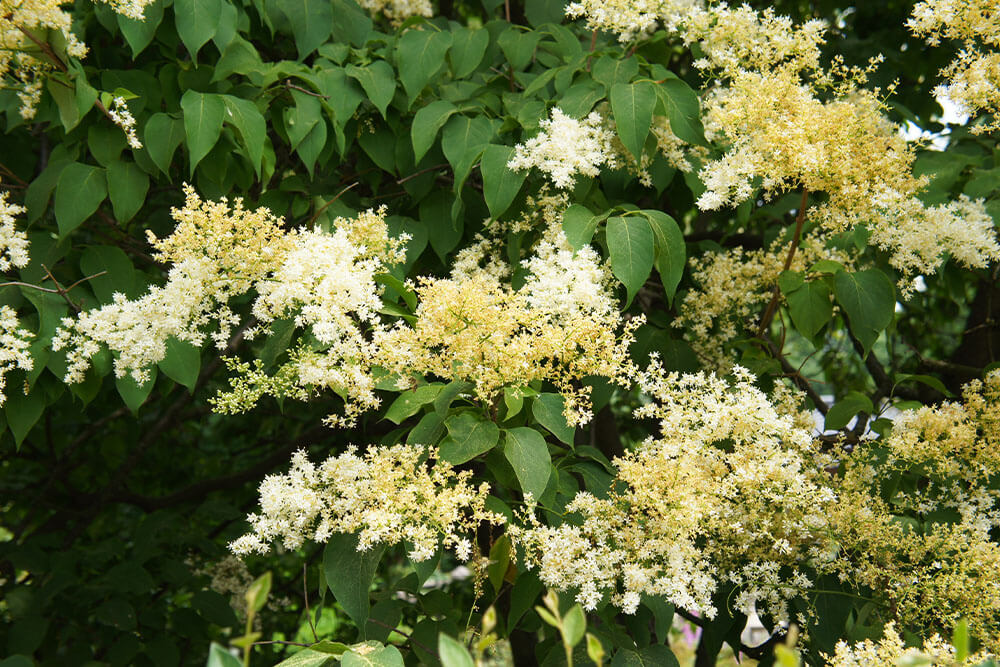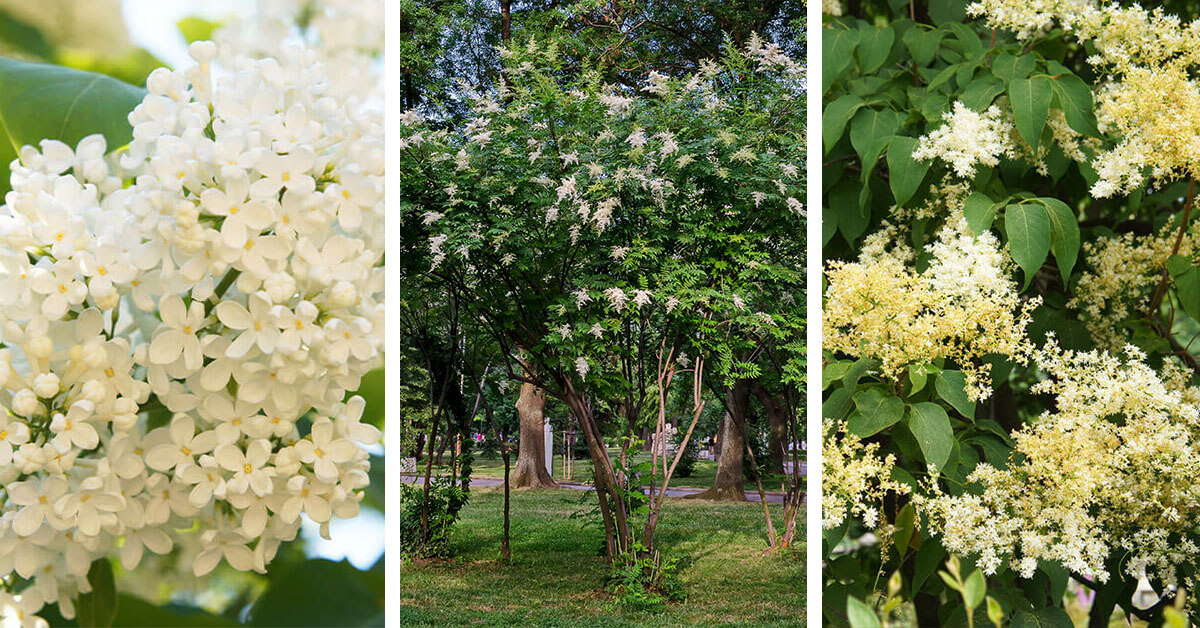It’s getting late in the summer. Many of your favorite flowers have lost their petals. The Japanese Lilac Tree steps in as a proverbial standby. Its stage is the landscape against which its striking green leaves and its creamy white flowers have just started opening. It is worth considering this tree for your home, and if so, it’s time to learn about Japanese Lilac tree care.
The Japanese Lilac is not your run-of-the-mill lilac tree that’s actually a shrub. It is a true tree. As the name implies, this tree is native to Japan. Even so, it grows well in any location between 3-7 on the USDA hardiness chart.
One of the most alluring visuals of the Japanese Lilac is its oval crown. The bark has a reddish tone and peels somewhat like birches. Then too, there are flowers (did we mention flowers?). They are not shy. They show brightly with a creamy-white hue. As they open, a light fragrance floats in the air. Who can resist?
Japanese Lilac Tree’s flowers attract beneficial pollinators, including hummingbirds and butterflies. Set up a tea table nearby and enjoy the scenery.
Key Takeaways
- Japanese Lilacs Bloom later in the season vs. regular lilacs, so it extends the flower life of your garden
- This tree is perfectly suited to urban environments because of its small stature.
- Unlike some spring bloomers, the Japanese Lilac has both its leaves and flowers at the same time. The vibrant green leaf makes a beautiful backdrop for the delicate buds.
- With proper Japanese Lilac care, the tree will establish healthy roots, helping it tolerate some dry conditions so long as you provide supplemental water.
The scent of Japanese Lilac is akin to a Privet shrub, somewhat sweet and grassy. But not as intense as lilac bushes. It is the most trouble-free tree among lilacs.
8 Observations on Japanese Lilac Tree Care
1. Varieties of Japanese Lilac
There are Cultivars of the Japanese Lilac Tree available. They include:
- Chantilly Lace: Here, you have the exciting addition of variegated foliage, with the leaves bordered in pastel yellow. Place them in partial sun, and they grow up to 30 feet.
- Golden Eclipse: True to its name, The leaves of this tree develop progressively golden edges throughout the season.
- Ivory Pillar: Grows 25 feet high, looking very columnar.
- Ivory Silk: Maxing out at 25 feet high, the Ivory Silk cultivar is the most popular, in part because it will develop flowers at an early age.
- Summer Snow: The benefit of this cultivar is that it grows half the size of the mother tree and it tolerates pollution.
In some areas, the Japanese Lilac Tree has become a popular “street tree,” especially in urban areas where there are power lines. Their stature is small enough to allay worries of falling branches.
2. How to plant a Japanese Lilac Tree
Similar to other blossoming trees, the Japanese Lilac benefits from an early spring planting. This timing supports healthy roots. Make sure you find a location with moist but well-drained soil. It does enjoy sunlight, and if there isn’t enough, the tree doesn’t flower as well.
If you have clay soil, you can still plant the tree. Just drain the area after heavy rains. Alternatively, you can make a dirt mount of about 20” above your soil and plant there. You do have to be somewhat patient for your reward, however. Wait until after the flowers complete their blooming cycle to prune. The Japanese Lilac Tree won’t flower for around three years.
Japanese Lilac Tree Needs In Review
- Add mulch to the tree’s bed
- Consistent moisture
- Deep watering every 7-10 days
- Find well-drained soil
- Place in full sunlight
Use a balanced product (10-10-10) annually in the spring. If you have a fireplace, use some of its ash on the ground. It helps moderate the alkalinity. For nitrogen, use coffee grounds sparingly.
3. Japanese Lilacs in a Crock?
There has been a trend toward having various types of trees as part of indoor decor. You can grow a Japanese Lilac in a container. But the question remains, should you?
If you’re planning on putting your lilac in a pot, you need tons of space for the roots. Think in terms of the biggest container you can find. It shouldn’t measure less than 24” wide and 12” deep. There is a simple equation here. The larger the pot, the better the insulation from extreme weather. Do not use black containers. They draw heat.
Perhaps the best idea for planting Japanese Lilacs in crocks is growing baby plants instead. Now you can use a 10” container so long as it has drainage holes. Put your cutting 2” down into the center of the pot. Make sure its edge is down, then temper the soil.
Water your new plant lightly and evenly. Place it in partial sunlight and watch it grow.
A Japanese Lilac’s scent is stronger when it grows in full sun. It is actually a member of the Oleaceae (Olive) family with 20 species. There are more than 1000 varieties of lilacs around the world.
4. Growing a Japanese Lilac as a Hedge

First things first. You need LOTS of room. Each tree should get 7-8 feet spaces apart for a hedge and 8-10 feet apart when designing a shrub. You’re looking for a location that receives at least six hours of sun daily for the best flowering.
When you put them into the soil, make sure it’s well drained and amend it with a little lime. Landscapers have a passion for Japanese Lilac hedges for their structure.
5. Wintering
Cover the base of your Japanese Lilac with 4” inches of mulch. If a really harsh freeze comes, you may need to cover the shrub, if practicable, using something like burlap.
In fall, once the flowers are gone, it’s time to cut back the tree for winter. Get rid of dead flowers and any damaged parts of the tree. This improves the health of the Lilac come spring.
Lilac’s Roots: In ancient Greece, there is a story of Pan, who loved a nymph named Syringa. He chased her through the forest, but she feared him. For camouflage, she shapeshifted into a Lilac. When Pan found the shrub, he used it to make his first panpipe. It’s worth noting that the Lilacs scientific name is Syringa.
6. Common Pests & Plant Diseases
For the most part, this tree doesn’t have a lot of problems with pests and diseases. This means Japanese Lilac tree care is much simpler than you might think.
They may get leaf spots, but if you trim them and throw away the leaves, you’re pretty much done. If the flowering shoots look unhealthy, develop black stripes or blotches, you may have a light-scale infestation. Again, get out the sickly parts. Fertilizing can sometimes amend this but not until you move the lilac to a new spot free of potential infestation.
Lilac Symbolism: Depending on the culture, lilacs had different meanings. For many, they were the harbinger of spring and renewal. The Celts thought the lilac’s smell was magical. Russians would hold a sprig of lilac over a newborn so the child would grow wise. The white color of the Japanese Lilac flowers is an emblem of pure intention and innocence.
7. Common Japanese Lilac Tree Problems

Temperature: While it likes the sun, excessive heat may result in leaf drop early in the season. Mind you, warmer winters can tamper with flower development, too.
Timing: If you prune at the wrong time, you can potentially remove buds forming for the following season.
Severe Pruning: A severely pruned plant may take a year or two to recover.
Soil: If the flower production seems low, you probably have too much nitrogen in the soil.
Lilac has been dubbed the Queen of Shrubs: likely alluding to its beauty. It is said that Lilac flowers promote peace and inner serenity.
8. Lilac Allure
Lilac is another edible petal, but most people prefer the aroma over the taste. But there are simple ways to bring your white blossoms into whimsical presentations. Fill a pitcher with ice and lilacs. Steep them and strain. You’ll get a hint of the scent as you drink.
Top a spring salad with freshly picked blossoms. If you’re feeling creative, put the Japanese lilac flowers in the bottom of a jar, Fill it with honey, and close it. Leave it for 6 weeks before using. Aromatherapy at its sweetest!
And there’s more. You can create lilac wine, tea, and shortbread cookies. Or, try candying the blossoms.
Only the petals of the japanese lilac tree are edible.
Suggestions for Successfully Growing Japanese Lilac Trees
The Japanese Lilac Tree’s care and keeping isn’t difficult so long as you have well-drained soil. It’s fairly resilient against bugs and disease. There’s no question this tree makes a statement piece no matter where you put it. And when the blossoms open, it’s like spring has arrived again. Under some circumstances, the Japanese Lilac can be mildly invasive, but if you tend to your tree, you have little worry. If you watch, you’ll see your Lilac Tree growing between 12-14” a year, which is considered moderate. It’s satisfying to see the tree flourish.
[wp-faq-schema title=”Frequently Asked Questions About Japanese Lilac Tree Care” accordion=1]


